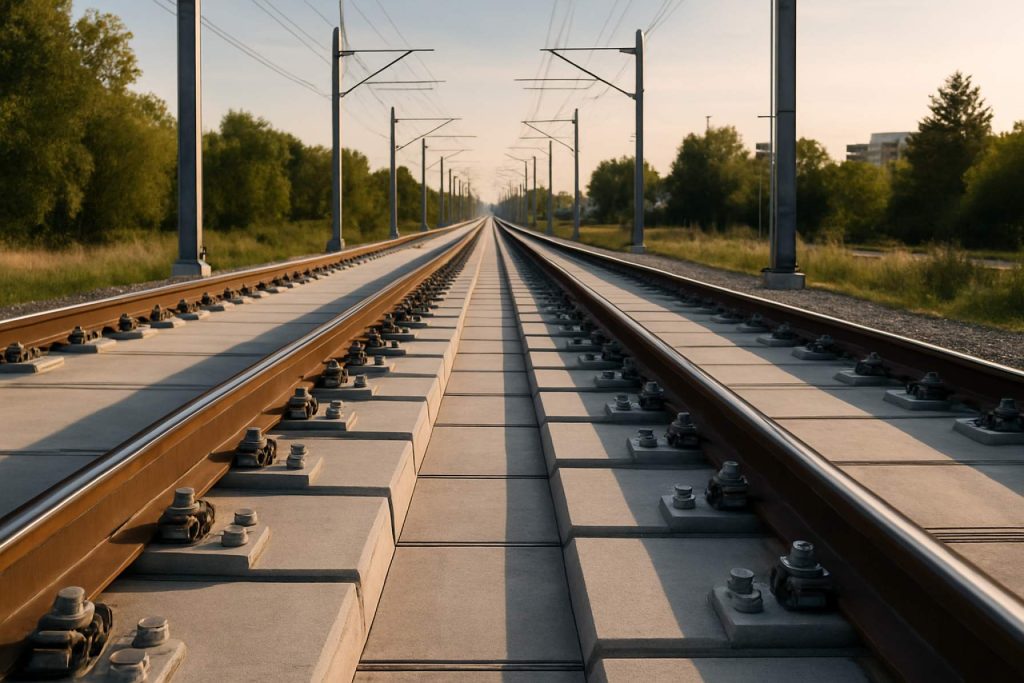
Ballastless Railway Track Systems Market Report 2025: In-Depth Analysis of Growth Drivers, Technology Advancements, and Global Opportunities. Explore Market Size, Forecasts, and Key Challenges Shaping the Industry.
- Executive Summary & Market Overview
- Key Technology Trends in Ballastless Railway Track Systems
- Competitive Landscape and Leading Players
- Market Growth Forecasts 2025–2030: CAGR and Revenue Projections
- Regional Analysis: Demand Hotspots and Investment Activity
- Future Outlook: Emerging Applications and Strategic Opportunities
- Challenges, Risks, and Market Entry Barriers
- Sources & References
Executive Summary & Market Overview
Ballastless railway track systems, also known as slab track systems, represent a significant evolution in rail infrastructure, replacing traditional ballast-based tracks with concrete or composite slabs. This design offers enhanced durability, reduced maintenance, and improved ride quality, making it increasingly attractive for high-speed, urban, and heavy-haul rail applications. As of 2025, the global market for ballastless railway track systems is experiencing robust growth, driven by expanding high-speed rail networks, urban transit modernization, and the need for long-term cost efficiencies.
According to recent industry analyses, the ballastless track market is projected to achieve a compound annual growth rate (CAGR) of over 5% between 2023 and 2028, with the Asia-Pacific region leading adoption due to extensive rail infrastructure investments in China, India, and Southeast Asia. Europe follows closely, propelled by ongoing upgrades to high-speed corridors and cross-border connectivity projects. Notably, China State Railway Group and Indian Railways have accelerated the deployment of slab track systems in new high-speed and metro lines, citing lower lifecycle costs and superior performance in challenging environments such as tunnels and viaducts (China State Railway Group; Indian Railways).
Key market drivers include:
- Urbanization and Population Growth: Rapid urban expansion is fueling demand for reliable, low-maintenance rail solutions in metropolitan areas.
- High-Speed Rail Expansion: Countries investing in high-speed rail favor ballastless systems for their stability at high velocities and reduced track deformation.
- Lifecycle Cost Savings: Although initial installation costs are higher, ballastless tracks offer significant savings over time due to minimal maintenance and longer service life.
- Environmental and Operational Benefits: The systems reduce noise, vibration, and dust, aligning with sustainability goals and improving passenger comfort.
Major industry players such as voestalpine Railway Systems, PORR Group, and STRABAG SE are actively innovating in slab track technologies, offering modular solutions tailored to diverse geographies and operational requirements. As governments and transit authorities prioritize resilient, future-proof infrastructure, ballastless railway track systems are poised to become the standard for next-generation rail networks worldwide (MarketsandMarkets).
Key Technology Trends in Ballastless Railway Track Systems
Ballastless railway track systems, also known as slab tracks, are rapidly transforming global rail infrastructure by replacing traditional ballasted tracks with concrete or composite slabs. As of 2025, several key technology trends are shaping the evolution and adoption of these systems, driven by the need for higher speed, lower maintenance, and improved durability in both high-speed and urban rail networks.
- Advanced Materials and Prefabrication: The use of high-performance concrete, fiber-reinforced polymers, and composite materials is enhancing the structural integrity and lifespan of ballastless tracks. Prefabricated slab modules are increasingly manufactured off-site, enabling faster installation and reducing on-site labor costs. This trend is particularly evident in projects across Europe and Asia, where rapid deployment is critical for network expansion (Siemens).
- Digitalization and Smart Monitoring: Integration of IoT sensors and digital twins is revolutionizing track maintenance. Real-time data collection on stress, temperature, and vibration allows predictive maintenance, minimizing downtime and extending asset life. Major rail operators are investing in these technologies to optimize lifecycle costs and ensure safety (DB Netz AG).
- Modular and Standardized Designs: Standardization of slab track components is facilitating interoperability and reducing project complexity. Modular systems, such as the Rheda 2000 and the ÖBB-PORR slab track, are being adopted for their proven performance and ease of integration into diverse rail environments (PORR Group).
- Noise and Vibration Mitigation: Innovations in elastomeric pads, under-slab mats, and floating slab technology are addressing environmental concerns by significantly reducing noise and ground-borne vibrations, especially in densely populated urban corridors (Getzner Werkstoffe).
- Green and Sustainable Solutions: Sustainability is a growing focus, with manufacturers developing low-carbon concrete mixes and recycling strategies for end-of-life slabs. Life cycle assessments are increasingly used to quantify environmental benefits over traditional ballasted systems (Arup).
These technology trends are expected to accelerate the global adoption of ballastless railway track systems, particularly in high-speed rail and metro projects, as operators seek to balance performance, cost, and sustainability in the coming years.
Competitive Landscape and Leading Players
The competitive landscape of the ballastless railway track systems market in 2025 is characterized by the presence of several established infrastructure and engineering firms, as well as specialized track technology providers. The market is driven by increasing investments in high-speed rail, urban transit modernization, and the need for durable, low-maintenance track solutions. Key players are leveraging advanced materials, proprietary installation techniques, and integrated digital monitoring systems to differentiate their offerings.
Leading companies in this sector include Vossloh AG, which offers the FFS (Feste Fahrbahn System) and has a strong presence in Europe and Asia, and PORR AG, known for its Slab Track Austria system, widely adopted in European high-speed and metro projects. Rail.One GmbH is another major player, providing the RHEDA 2000® system, which has been implemented in over 4,000 km of track worldwide. In Asia, China Railway Construction Corporation Limited (CRCC) dominates the market, particularly through large-scale deployment of ballastless tracks in China’s extensive high-speed rail network.
Japanese firms such as Kajima Corporation and Taiheiyo Cement Corporation have pioneered slab track systems for Shinkansen lines, focusing on seismic resilience and lifecycle cost reduction. In addition, STRABAG SE and Balfour Beatty plc are active in the European market, often collaborating with national rail authorities on turnkey projects.
The competitive dynamics are further shaped by strategic partnerships, technology licensing, and joint ventures. For example, Siemens Mobility collaborates with local contractors to integrate digital track monitoring and predictive maintenance solutions, enhancing the value proposition of ballastless systems. Market entry barriers remain high due to the capital-intensive nature of projects, stringent safety standards, and the need for proven long-term performance data.
Overall, the market in 2025 is expected to see intensified competition as governments prioritize sustainable rail infrastructure and as emerging players from regions such as India and the Middle East seek to localize production and adapt global technologies to regional requirements. The focus on innovation, cost efficiency, and lifecycle management will continue to define the strategies of leading players in the ballastless railway track systems market.
Market Growth Forecasts 2025–2030: CAGR and Revenue Projections
The global ballastless railway track systems market is poised for robust growth between 2025 and 2030, driven by increasing investments in high-speed rail infrastructure, urban transit modernization, and the need for reduced maintenance costs. According to recent market analyses, the ballastless track segment is expected to register a compound annual growth rate (CAGR) of approximately 5.8% during this period, outpacing traditional ballasted track systems due to its superior durability and lifecycle advantages.
Revenue projections indicate that the market, valued at around USD 7.2 billion in 2025, could reach USD 9.6 billion by 2030. This growth is underpinned by large-scale projects in Asia-Pacific, particularly in China, India, and Southeast Asia, where governments are prioritizing high-speed and metro rail expansions. For instance, China’s ongoing investment in its high-speed rail network and India’s dedicated freight corridors are significant contributors to market demand Statista.
Europe is also expected to witness steady growth, with the European Union’s Green Deal and sustainable mobility initiatives encouraging the adoption of ballastless systems for new and upgraded rail lines. The region’s focus on reducing carbon emissions and enhancing rail efficiency further supports this trend European Commission.
Key market players, including Siemens AG, voestalpine AG, and Larsen & Toubro, are investing in R&D to develop advanced ballastless track solutions that offer improved vibration damping, faster installation, and lower lifecycle costs. These innovations are expected to further accelerate market adoption, especially in regions with challenging geotechnical conditions or where high-speed operations are prioritized.
In summary, the ballastless railway track systems market is set for significant expansion from 2025 to 2030, with a strong CAGR and rising revenues reflecting the global shift toward modern, low-maintenance, and high-performance rail infrastructure.
Regional Analysis: Demand Hotspots and Investment Activity
The global market for ballastless railway track systems in 2025 is characterized by pronounced regional disparities in both demand and investment activity. Asia-Pacific remains the dominant hotspot, driven by large-scale high-speed rail projects and urban transit expansions in China, India, and Southeast Asia. China, in particular, continues to lead with extensive deployment of ballastless tracks across its high-speed rail network, supported by ongoing government investment and a focus on reducing long-term maintenance costs. According to China State Railway Group, over 80% of new high-speed lines commissioned in 2025 are expected to utilize ballastless systems, reflecting a mature market with robust domestic supply chains.
India is rapidly emerging as a significant growth market, with the Mumbai-Ahmedabad High-Speed Rail Corridor and several metro projects specifying ballastless track technology to meet durability and performance requirements. The Indian government’s “Make in India” initiative is also attracting foreign direct investment and technology transfer from established European and Japanese suppliers, as reported by National High Speed Rail Corporation Limited.
In Europe, investment activity is concentrated in countries modernizing legacy infrastructure and expanding cross-border high-speed corridors. Germany, France, and Spain are at the forefront, leveraging EU funding mechanisms such as the Connecting Europe Facility to upgrade key routes with ballastless systems for improved reliability and lifecycle cost savings. The European Commission highlights that over €2 billion in grants were allocated in 2024-2025 for track modernization, with a significant share directed toward ballastless technology.
The Middle East is another emerging demand hotspot, particularly in the Gulf Cooperation Council (GCC) states. The Riyadh Metro and Etihad Rail projects in Saudi Arabia and the UAE, respectively, are adopting ballastless tracks to address challenging climatic conditions and ensure long-term stability. According to Etihad Rail, the adoption of ballastless systems is a strategic choice for desert environments, where sand ingress and temperature fluctuations pose significant challenges to traditional ballasted tracks.
In contrast, North America’s adoption remains limited, with investment focused primarily on select urban transit projects and pilot high-speed corridors. The region’s legacy freight-oriented infrastructure and cost considerations continue to slow widespread uptake, as noted by Association of American Railroads.
Future Outlook: Emerging Applications and Strategic Opportunities
The future outlook for ballastless railway track systems in 2025 is shaped by a convergence of technological innovation, urbanization trends, and strategic infrastructure investments. As global rail networks expand and modernize, ballastless track systems—characterized by their use of concrete or composite slabs instead of traditional ballast—are increasingly recognized for their durability, reduced maintenance needs, and suitability for high-speed and urban rail applications.
Emerging applications are particularly prominent in high-speed rail corridors, metro systems, and tunnels, where the stability and longevity of ballastless tracks offer significant operational advantages. For instance, countries such as China, Germany, and Japan are accelerating the adoption of ballastless systems in new high-speed rail projects to support speeds exceeding 300 km/h, minimize track deformation, and reduce lifecycle costs. The China State Railway Group and Deutsche Bahn AG have both reported ongoing investments in slab track technology for flagship routes and urban transit expansions.
Strategic opportunities are also emerging in the context of sustainability and digitalization. Ballastless tracks facilitate the integration of smart monitoring systems, enabling predictive maintenance and real-time performance analytics. This aligns with the broader industry shift toward digital railways, as highlighted by Siemens AG and Alstom SA, which are developing advanced track monitoring solutions tailored for slab track infrastructure. Additionally, the reduced need for ballast extraction and replacement supports environmental goals, making ballastless systems attractive for projects seeking to minimize ecological impact.
- Urban Transit Expansion: Rapid urbanization is driving demand for metro and light rail systems, where ballastless tracks offer space-saving and noise-reduction benefits, as seen in projects by MTR Corporation and Tokyo Metro Co., Ltd..
- High-Speed Rail: The global high-speed rail market is forecast to grow, with ballastless tracks forming the backbone of new lines in Europe and Asia (European Union Agency for Railways).
- Resilience and Climate Adaptation: Ballastless systems are being evaluated for their resilience to extreme weather, supporting infrastructure adaptation strategies in response to climate change (International Union of Railways).
In summary, 2025 is poised to see ballastless railway track systems move from niche to mainstream, driven by their alignment with high-speed, urban, and sustainable rail development priorities worldwide.
Challenges, Risks, and Market Entry Barriers
The adoption and expansion of ballastless railway track systems face several significant challenges, risks, and market entry barriers as of 2025. While these systems offer advantages such as reduced maintenance and longer service life, their implementation is hindered by a combination of technical, financial, and regulatory factors.
- High Initial Capital Expenditure: One of the most prominent barriers is the substantial upfront investment required for ballastless track construction. Compared to traditional ballasted tracks, the cost of materials, specialized construction techniques, and advanced machinery is considerably higher. This financial hurdle can deter both public and private sector stakeholders, especially in regions with constrained infrastructure budgets (European Union Agency for Railways).
- Complex Installation and Engineering Requirements: Ballastless systems demand precise engineering and construction expertise. The installation process is less forgiving of errors, as the rigid structure offers little tolerance for misalignment or subgrade imperfections. This necessitates highly skilled labor and advanced quality control measures, which may not be readily available in all markets (Siemens AG).
- Longer Construction Timelines: The meticulous nature of ballastless track installation often results in longer project timelines compared to ballasted alternatives. This can delay the return on investment and disrupt existing rail operations, posing a risk for operators seeking rapid network expansion (Railway Gazette International).
- Limited Retrofit Compatibility: Retrofitting existing ballasted lines with ballastless systems is technically challenging and costly. The process may require extensive subgrade preparation and, in some cases, complete track closure, further increasing operational risks and costs (DB Netz AG).
- Regulatory and Standardization Hurdles: The lack of harmonized international standards for ballastless track design and performance can complicate cross-border projects and slow market adoption. Regulatory approval processes may be lengthy and uncertain, particularly in countries with limited prior experience in ballastless technology (International Union of Railways (UIC)).
- Market Entrant Challenges: New entrants face steep learning curves and must invest heavily in R&D, certification, and local partnerships to compete with established players who possess proprietary technologies and proven track records (voestalpine AG).
These challenges collectively shape the competitive landscape and influence the pace of global adoption for ballastless railway track systems in 2025.
Sources & References
- voestalpine Railway Systems
- PORR Group
- STRABAG SE
- MarketsandMarkets
- Siemens
- Getzner Werkstoffe
- Arup
- Vossloh AG
- Rail.One GmbH
- Kajima Corporation
- Taiheiyo Cement Corporation
- Balfour Beatty plc
- Statista
- European Commission
- Larsen & Toubro
- Etihad Rail
- Association of American Railroads
- Alstom SA
- MTR Corporation
- Tokyo Metro Co., Ltd.
- European Union Agency for Railways
- International Union of Railways
- Railway Gazette International



